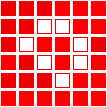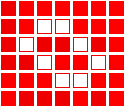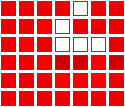Conway's Game of Life
Conway's Game of Life is a set of rules that governs the behaviour of a 2-dimensional
cell pattern.
The pattern develops stepwise. Each step is called a generation.
A cell is represented by a square in a rectangular pattern such that each cell has 8 neighbours.
The living cells ( that are coloured to differ from the background ) obey
a simple rule that decides their fate in the next generation:
A living cell survives if it has 2 or 3 living neighbours.
(If it has 0 or 1 living neighbour it is starved to death and if it has 4 or more living neighbours
it is choked to death.)
The other important rule is:
A new living cell is born in a square that has exactly 3 living neighbours*.
These two simple rules have an amazing potential to generate complex and interesting
new patterns depending on the initial pattern.
It turns out that regardless of initial pattern a certain set of stable cellular figures
tend to appear. In the end the whole pattern (usually) becomes stable
and the final pattern is made up by a swarm of these stable figures.
Conway's Game of Life can therefore be thought of as a simulation of a darwinian
evolution (or of the forming of stable atoms and molecules from an initial chaotic state) where the stable figures represent those species that are fit enough to survive.
*) The fact that the number 3 is odd makes it possible in a two-colour game to decide the majority colour, i.e. the colour that is in majority among the neighbours of a certain cell.
In the suggested Black&White Life Game it is a rule that a newborn cell gets the majority colour.
Here below are some of the most common stable figures.
It should be noted that apart from the stable patterns there also appear
cyclic patterns (such as the Blinker) and even moving cyclic patterns (such as the Glider).
 |  | 
|  |  |
| Blinker | Block | Tub | Boat | Beehive |
 |  | 
|  |
| Loaf | Pond | Mango | Glider |



